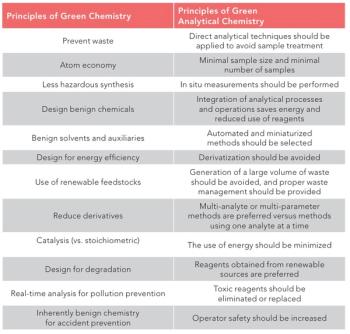
- The Column-06-19-2014
- Volume 10
- Issue 11
Thinking Small: The Benefits and Challenges of Miniaturization
This article describes the advantages of miniaturizing laboratory instruments, as well as the challenges to adapt to and overcome
Tasks once performed by instruments that took up the space of an entire laboratory can now be accomplished on a device that fits into the palm of your hand. This article describes the advantages of miniaturizing laboratory instruments, as well as the challenges to adapt to and overcome.
In the mid-1940s, the world's first electronic general-purpose computer was produced, dubbed ENIAC (Electronic Numerical Integrator and Computer). ENIAC was developed at a cost of ~$6 million USD (adjusted for today's value), took up 1800 square feet (167 m2), and consumed 150 kW of power.1 Today, nearly 70 years later, we hold vastly more computing power in our mobile phones than that first computer did — all because of the constant push towards miniaturization.
PHOTO CREDIT: JONATHAN KITCHEN/GETTY IMAGES
This same drive to reduce the size of technology has certainly played a factor in laboratory and clinical diagnostic instrument design too, with the parallel development of "lab-on-a-chip" techniques, micro- and nano-scale chromatography systems, as well as a flurry of effort on enhanced professional "point of care" (PPOC) devices. This is understandable, given the tremendous benefits miniaturization offers. Even so, mingled with the advantages offered by reduced-size technology are a few limitations that should be considered by anyone making the move towards miniaturization of laboratory equipment.
Key Benefits of Miniaturization
There are a number of key advantages that miniaturization offers users of analytical equipment. These are typically grouped into two main areas:
Portability: Miniaturization of analytical instrumentation makes it easier to move the analysis equipment from laboratory to laboratory, which reduces the risk of sample contamination or loss through mishandling.
From a life science perspective — and especially in PPOC applications — having more portable equipment allows analyses to be performed in critical care units and operating rooms, offering enhanced convenience for the patient with the added benefit of more "real-time" results. Miniaturization also allows these tests to be performed on-site during disaster relief efforts; in support of forensics testing; or in the face of bioterrorism and chemical warfare threats, which adds to the benefits of increased portability.2 For "lab-on-a-chip" techniques, ever-increasing complexity of chip design allows for more sophisticated analyses to be performed wherever the analyst desires. This coupled with the ability to fabricate these chips in a relatively short period of time add to the attractiveness of these miniaturized pieces of equipment.
Reduced Fluid Volumes: As instrumentation reduces in overall size, so do fluid volumes used in the analyses, which subsequently offers scientists several ancillary advantages:
- Sample size reduction — Smaller analysis pathways require smaller sample sizes. By requiring less sample for each analysis, sample preparation time as well as sample handling efforts are reduced. For PPOC applications, a reduction in sample size can offer significant advantages for patients, when obtaining samples for analysis can be more challenging (for example, infants, geriatric patients, oncology patients, and pets). In high performance liquid chromatography (HPLC) and related chromatographic techniques, using smaller sample sizes allows the limited amount of sample available to be used for more analyses and for further testing and characterization.
- Reagent volume reduction — Smaller flow paths can affect rising costs of reagent handling and disposal when working with smaller volumes of reagents — especially in key areas like chromatography.
- Faster analysis times — Because fluid passageways are typically much smaller in diameter and length, there is less opportunity for dispersion to occur, which in turn allows for faster overall analysis times and subsequent increased daily analysis capacity for each system.
- Lowered operational costs — Overall costs of operation — including power consumption, reagent consumption and disposal, and consumables disposal — tend to be lower with miniaturized equipment, thus making the per-sample costs less for and improving the profitability position of the laboratory.
Key Challenges of Miniaturization
As with any technological advance, in addition to the advantages, there are challenges and limitations that the newer technology introduces. That is certainly the case with the miniaturization of laboratory equipment.
Differences with Standard-Scale Equipment: Because of the change in scale, the often dramatic differences that exist between standard-scale equipment and miniaturized equipment can be problematic, for the following reasons:
- Results can be significantly different — With the scale factors related to miniaturized equipment analyses being so different from those of more standard equipment, it can be challenging to directly correlate the results obtained from miniaturized systems to more standard systems. This can lead to repeat testing, as well as to misinterpreted results. In PPOC applications, this can result in misdiagnosis or missed diagnosis resulting in patient suffering.3 In chromatographic applications, the scale factor differences can lead to substantial shifts in peak shapes, retention times, etc., that may force the chromatographer to recharacterize the overall analysis to properly reflect the data generated.
- Lack of regulation and standardization — Currently, there is not as much regulation purporting to miniaturized equipment, nor is there true commercial standardization as exists with larger-scale equipment.3 This makes it challenging to adopt the smaller-scale equipment across multiple sites and throughout various industry segments. In addition, miniaturized equipment is frequently not as easy to maintain and therefore typically does not receive the same routine maintenance and care that larger equipment receives. This can lead to increased overall costs as a result of disposal and the overheads required to keep additional equipment on hand.
- Smaller samples lead to undesired variability — With an ever-shrinking sample size commensurate with the reduced size of equipment, it is possible to get interference from variables that are not present with larger-scale analyses. For example, nano-scale chromatography can yield statistically invalid results because of naturally-occurring isotopic variances. In PPOC applications, by comparison, smaller sample sizes create opportunities for interference from interstitial fluids or can introduce variances from how the sample is sourced (for example, capillary versus venous sampling).3
Hardware and Connections: Interfacing between miniaturized equipment and the outside world is not as straightforward as might be initially thought.
In the area of chromatography, the effort to miniaturize on a commercial level has seen reductions in overall system design as well as in the fluidic pathway more specifically. Examples of commercial miniaturization include smaller column sizes, where columns have migrated away from the standard 4.6 mm i.d. × 250 mm length columns to 1–2 mm i.d. columns that are 100-mm long and are packed with much smaller packing material to maintain the separation efficiency and theoretical plates offered by the larger columns while facilitating faster analysis times. The tubing used for the miniaturized chromatography systems tends to migrate away from 1/16" o.d. × 0.010" i.d. — long the "standard" size of HPLC — to tubing that has a 1/32" or 360-µm o.d. and inner diameters of 100 µm or less. Used with the smaller columns and tubing are fittings with smaller (and varied) threaded configurations. These can lead to confusion and frustration when trying to make proper connections with these systems.
Conclusion
Current trends in laboratory equipment design have led to the continued development of ever-smaller technology and the miniaturization of laboratory equipment. The smaller-scale equipment offers unique benefits that cannot be matched by more traditional, larger-scale equipment, especially in the areas of portability and reduced fluid volumes that offer numerous ancillary advantages and benefits in both areas of traditional analytical chemistry as well as PPOC applications. Yet, the miniaturization of laboratory equipment has brought with it a unique set of challenges that are not easily overcome; these must be addressed for the smaller-scale equipment to be accepted in the industry. As more and more effort is put into developing portable chip-based chromatography systems (liquid chromatography–mass spectrometry [LC–MS], gas chromatography–mass spectrometry [GC–MS]) and equipment for similar techniques — and as innovation in clinical diagnostics continues towards the development of standardized cartridge or card-based tests with more portable equipment — the anticipation is that these current challenges will be met and miniaturization will continue to evolve in the chromatography sector.
References
1. "ENIAC" Wikipedia, 5 June 2014. Web. 9 June 2014,
2. G. Kost, Use of Small-World Networks & Technological Advances in Point of Care for Disaster Preparedness, Response & Resilience — 2 Steps to the Final Frontier (POC Culture)!" Presented at the Disaster Point of Care Forum AACC Annual Meeting and Clinical Lab Expo, Houston, Texas, USA, 2013.
3. A. Okorududu, "Optimizing Accuracy and Precision for Point of Care Testing (POCT) in Specific Clinical Settings." Presented at the Brown Bag Session AACC Annual Meeting and Clinical Lab Expo, Los Angeles, California, USA, 2012.
John Batts joined Upchurch Scientific in 1996 as its first technical specialist and has worked for the company (now IDEX Health & Science) in a variety of roles in the past 18 years. He currently works as a senior-level technical specialist and is also involved in training sessions with customers and employees. Before joining IDEX Health & Science, John worked for the US Food and Drug Administration research laboratory in St Louis, Missouri, USA, as well as in private industry as a chromatographer. John obtained his Bachelor of Arts in Mathematics and Chemistry from Lindenwood University (Missouri, USA), graduating in 1992.
Leanne Elson joined IDEX Health & Science as a senior applications scientist in 2010. She currently works in R&D and is also involved in training employees. Before joining IDEX Health & Science, Leanne worked in the clinical diagnostic laboratory field for the past 26 years as a microbiologist, as well as in clinical diagnostic sales for Roche Diagnostics, Nichols Institute Diagnostics, and Bartels Incorporated. Leanne obtained her Master of Science in Preventive Medicine in 1997 and Bachelor of Science in Microbiology in 1988, both from The Ohio State University, USA.
E-mail:
Website:
This article is from The Column. The full issue can be found here:
Articles in this issue
over 11 years ago
Incognito: Zero to Hero... The Power of the Review Articleover 11 years ago
International Conference on Packed Column SFC (SFC 2014)over 11 years ago
Teaching Old Drugs New Tricksover 11 years ago
Profiling MDMA Impurities Using HS–SPMEover 11 years ago
DBS in Dopingover 11 years ago
Optimizing Viral Vector Purificationover 11 years ago
New LC–MS–MS Method to Detect Counterfeit Drugsover 11 years ago
Vol 10 No 11 The Column June 19, 2014 North American PDFover 11 years ago
Vol 10 No 11 The Column June 19, 2014 Europe and Asia PDFNewsletter
Join the global community of analytical scientists who trust LCGC for insights on the latest techniques, trends, and expert solutions in chromatography.




